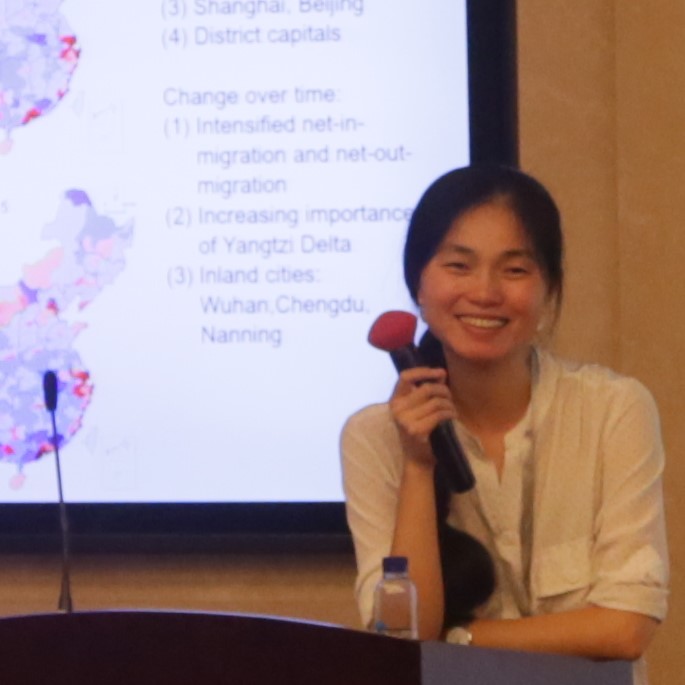 Chen Chen is Associate Professor in the Asian Demographic Research Institute. She received her Ph.D. in Geography from UCLA. Chen uses quantitative and qualitative methods to understand changing patterns of internal migration in China and international migration to China, including in relation to family, gender and generation. She also investigates gender and education selectivity in migration processes through global comparisons.
Chen Chen is Associate Professor in the Asian Demographic Research Institute. She received her Ph.D. in Geography from UCLA. Chen uses quantitative and qualitative methods to understand changing patterns of internal migration in China and international migration to China, including in relation to family, gender and generation. She also investigates gender and education selectivity in migration processes through global comparisons.
▶Download CV ✉ chenchen923@shu.edu.cn
Selected Publications
Li, Zhen and Chen, Chen. 2020. “Current patterns of inter-provincial return migration and the relocation of inter-provincial return migrants in China: A study based on fixed-interval migration data.” Renkou yu Fazhan (Population and Development), (4): 2-13 (in Chinese).
Chen, Chen. 2019. “Why migrant workers in China continue to build large houses in home villages: A case study of a migrant-sending village in Anhui.” Modern China, 46(5):521-554. https://doi.org/10.1177/0097700419875393
Chen, Chen and C. Cindy Fan. 2018. “Gender and generational differences in first outward-and first inward-moves: An event-history analysis of rural migrants in China.” Environment and Planning A: Economy and Space, 50(8), 1646-1669. https://doi.org/10.1177%2F0308518X18782709
Chen, Chen. 2018. “The risk of conducting the first return migration between 1980 and 2009 -- A survival analysis of migrant workers’ individual migration history.” Renkou yu Jingji (Population and Economy), (5): 91-99 (in Chinese).
C. Cindy Fan and Chen, Chen. 2014. “The new-generation migrant workers in China”, in Rural Migrants in Urban China: Enclaves and Transient Urbanism, edited by Fulong Wu et al., Routledge: 17-35.
Bai, Nansheng, Chen, Chen, and Long Wenjin. 2011. “The impact of rural-urban migration on left- behind children's educational performance”, in Left-behind Population in Rural China, Social Sciences Academic Press: 26-42 (in Chinese).
Bai, Nansheng, Li, Jing and Chen, Chen. 2007. “Children’s migration, income transfer and agricultural labor supply of rural elders: An empirical study of left-behind elderly in Anhui, China”. Zhongguo Nongcun Jingji (China Rural Economics) (10): 46-52 (in Chinese).
Teaching Courses
📖Anthropology of Risk and Disasters
Every year, thousands of people die in disasters, millions are displaced, and billions of dollars are lost in damages. Are disasters natural? How does culture shape the experience and actions of victims, volunteers, and response agencies? Through investigating the perspectives and experiences of survivors and of the staff members at NGOs and governmental agencies, including as reflected in ethnographies, oral histories and films, this course aims at understanding how risk perception and disaster response are interacting with contemporary politics, economic trends, gender and ethnic relations, technological advancement, climate change and globalization. In this course, you will be expected to do reading, participate in class discussions and presentations, complete homework assignments, and turn in the final paper. Classes will include lecture, discussion of readings, and student presentations.
Schedule:
Week 1: Course overview; Anthropological perspectives of risks and disasters
Week 2: Vocabulary in Anthropology; risk; vulnerability
Week 3: Key terms and theories in Anthropology of risks and disasters
Week 4: Vulnerability and resilience
Week 5: Risks, disasters, and modernity
Week 6: Ethnography and methods in Anthropology
Week 7: Gender in disasters
Week 8: policy, economy, and disasters
Week 9: Localization of risk perception and disaster response
Week 10: Student presentation of the final paper
📖Population Geography
Is an aging population something to worry about? What are the effects of family-planning policies? Do migrants compete with locals for jobs? Many of today’s critical social issues are related to population size, structure, or composition, and where these issues occur can make the answers different. Population geographers study how location matters to demographic issues and processes. This course is an introduction to population geography. Major topics in this course include fertility, mortality, and migration, with a focus on how they differ across time and space. With respect to each of these topics, we will learn a set of tools for measuring and describing population processes, data, and population composition. We will also discuss how social issues are related to demography and population geography.
Three major sets of questions will be explored in this course:
What do we know about a population at certain time, in a particular place? (What data sources are available? How can the data be modeled? How can we interpret the data?)
What is the significance of population size, structure, composition, and change? How do these aspects of population affect the economy, society, and culture?
How do populations compare across different regions and what can we learn from the comparisons?
At the end of this course, students should be able to evaluate claims about population issues that occur in different socioeconomic contexts. You should also understand what population geographers do and how they conduct their research. You will also gain some insight into how population geography is relevant to other areas of social science.
Schedule:
Week 1: Introduction
Week 2: Population Data
Week 3: Fertility
Week 4: Mortality
Week 5: Internal Migration
Week 6: International Migration
Week 7: Refugees & internally displaced persons
Week 8: Population Policies
Week 9: Practicing Population Geography
Week 10: In-class Presentation